The Maastrichtian is, in the ICS geologic timescale, the latest age of the Late Cretaceous epoch or Upper Cretaceous series, the Cretaceous period or system, and of the Mesozoic era or erathem. It spanned the interval from 72.1 to 66 million years ago. The Maastrichtian was preceded by the Campanian and succeeded by the Danian.

Plesiopleurodon is an extinct genus of Mesozoic marine reptiles, belonging to Sauropterygia, known from the Late Cretaceous of North America. It was named by Kenneth Carpenter based on a complete skull with a mandible, cervical vertebra, and a coracoid. In naming the specimen, Carpenter noted "Of all known pliosaurs, Plesiopleurodon wellesi most closely resembles Liopleurodon ferox from the Oxfordian of Europe, hence the generic reference." It was initially described as a pliosaur due to it short neck, a common trait of the family, although it is in the order Plesiosauria. However, later exploration into the relationships of both orders indicate that not all pliosaurs have short necks and not all plesiosaurs have long necks.

Dolichorhynchops is an extinct genus of polycotylid plesiosaur from the Late Cretaceous of North America, containing three species, D. osborni, D. bonneri and D. tropicensis, as well as a questionably referred fourth species, D. herschelensis. Dolichorhynchops was an oceangoing prehistoric reptile. Its Greek generic name means "long-nosed face".

The Bearpaw Formation, also called the Bearpaw Shale, is a geologic formation of Late Cretaceous (Campanian) age. It outcrops in the U.S. state of Montana, as well as the Canadian provinces of Alberta and Saskatchewan, and was named for the Bear Paw Mountains in Montana. It includes a wide range of marine fossils, as well as the remains of a few dinosaurs. It is known for its fossil ammonites, some of which are mined in Alberta to produce the organic gemstone ammolite.

Scanisaurus is a dubious genus of plesiosaur that lived in what is now Sweden and Russia during the Campanian stage of the Late Cretaceous period. The name Scanisaurus means "Skåne lizard", Skåne being the southernmost province of Sweden, where a majority of the fossils referred to the genus have been recovered. The genus contains one species, S. nazarowi, described in 1911 by Nikolay Bogolyubov as a species of Cimoliasaurus based on a single vertebral centrum discovered near Orenburg, Russia.

The Niobrara Formation, also called the Niobrara Chalk, is a geologic formation in North America that was deposited between 87 and 82 million years ago during the Coniacian, Santonian, and Campanian stages of the Late Cretaceous. It is composed of two structural units, the Smoky Hill Chalk Member overlying the Fort Hays Limestone Member. The chalk formed from the accumulation of coccoliths from microorganisms living in what was once the Western Interior Seaway, an inland sea that divided the continent of North America during much of the Cretaceous. It underlies much of the Great Plains of the US and Canada. Evidence of vertebrate life is common throughout the formation and includes specimens of plesiosaurs, mosasaurs, and pterosaurs as well as several primitive aquatic birds. The type locality for the Niobrara Chalk is the Niobrara River in Knox County in northeastern Nebraska.

The Blesa Formation is a geological formation in Teruel and La Rioja, Spain whose strata date back to the Barremian of the Early Cretaceous. Dinosaur remains as well as eggs are among the fossils that have been recovered from the formation. Along with the fragmentary anhanguerian pterosaur Iberodactylus. While the lower and upper parts of the formation were deposited in a continental setting, the middle portion of the formation is largely nearshore marine, with remains of plesiosaurs.
Orophosaurus is an dubious genus of elasmosaurid plesiosaur from the Late Cretaceous of New Mexico.
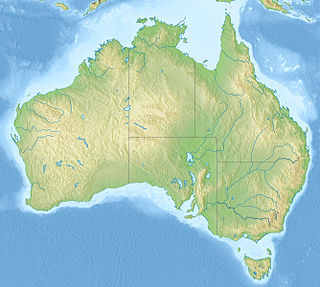
The Wallumbilla Formation is an Aptian geologic formation found in Australia. Plesiosaur remains are among the fossils that have been recovered from its strata.

The Conway Formation is a Campanian to Danian geologic formation in the South Island of New Zealand and therefore crosses the Cretaceous–Paleogene boundary. Plesiosaur remains are among the fossils that have been recovered from its strata. The Conway Formation is part of the Eyre Group and Haerenga Supergroup.

The Mancos Shale or Mancos Group is a Late Cretaceous geologic formation of the Western United States.
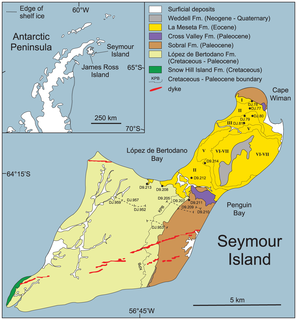
The Snow Hill Island Formation is a Late Campanian geologic formation found on James Ross Island, James Ross Island group, Antarctica. Remains of a paravian theropod Imperobator antarcticus have been recovered from it, as well as the Elasmarian ornithopods Trinisaura santamartaensis and Morrosaurus antarcticus, the Nodosaurid Antarctopelta oliveroi, and the shark Notidanodon sp.. Alongside these described genera are also the remains of indeterminate elasmosaurs, lithostrotian titanosaurs and an indeterminate Pterosaur.

The Araripe Basin is a rift basin covering about 8,000 square kilometres (3,100 sq mi), in Ceará, Piauí and Pernambuco states of northeastern Brazil. It is bounded by the Patos and Pernambuco lineaments, and is situated east of the Parnaíba Basin, southwest of the Rio do Peixe Basin and northwest of the Tucano and Jatobá Basins.
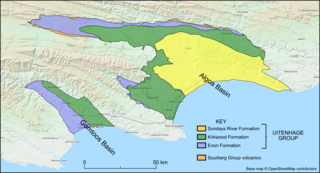
The Uitenhage Group is one of three geological groups, which comprise the onshore and offshore post-Karoo middle to lower Upper Mesozoic geological rock units in South Africa. Stratigraphically, the Uitenhage Group overlies the Suurberg Group and is overlain by the Algoa Group. It contains four formations that range in age from late Early Jurassic and late Early Cretaceous in age.
Pilmatueia is a diplodocoid sauropod belonging to the family Dicraeosauridae that lived in Argentina during the Early Cretaceous.

The Santana Group is a geologic group, formerly included as the middle part of the Araripe Group, in the Araripe Basin of northeastern Brazil. The group comprises the Crato, Ipubi and Romualdo Formations and is dated to the Aptian to Albian stages of the Early Cretaceous. The formations of the group were deposited in a lacustrine to subtidal shallow marine environment in the Araripe rift basin.
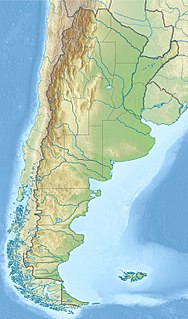
The Cañadón Asfalto Basin is an irregularly shaped sedimentary basin located in north-central Patagonia, Argentina. The basin stretches from and partly covers the North Patagonian Massif in the north, a high forming the boundary of the basin with the Neuquén Basin in the northwest, to the Cotricó High in the south, separating the basin from the Golfo San Jorge Basin. It is located in the southern part of Río Negro Province and northern part of Chubut Province. The eastern boundary of the basin is the North Patagonian Massif separating it from the offshore Valdés Basin and it is bound in the west by the Patagonian Andes, separating it from the small Ñirihuau Basin.
Iserosaurus is an extinct genus of sea turtle from the Late Cretaceous of Czech Republic.
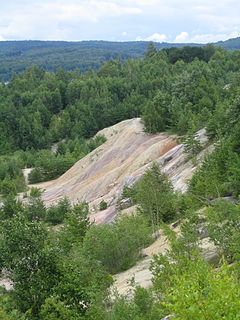
The Kristianstad Basin is a Cretaceous-age structural basin and geological formation in northeastern Skåne, the southernmost province of Sweden. The basin extends from Hanöbukten, a bay in the Baltic Sea, in the east to the town of Hässleholm in the west and ends with the two horsts Linderödsåsen and Nävlingeåsen in the south. The basin's northern boundary is more diffuse and there are several outlying portions of Cretaceous-age sediments. During the Cretaceous, the region was a shallow subtropical to temperate inland sea and archipelago.

The Bulldog Shale is a formation of Early Cretaceous age that forms part of the Marree Subgroup of the Rolling Downs Group, located in the Eromanga Basin of South Australia, Queensland and New South Wales.















